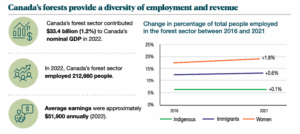How forests benefit Canadians
A key contributor to the economy
While the Canadian forest sector represents a smaller percentage of Canada’s economy than other resource sectors, it contributes more to the balance of trade for every dollar of value added and accounts for about six per cent of Canada’s total exports in 2022. Furthermore, in 2022, the sector generated $2.3 billion in revenue for provincial and territorial governments and contributed approximately $33.4 billion to Canada’s nominal gross domestic product (GDP).

A key contributor to our communities
Throughout Canada’s history, the forest products industry has been one of the most significant contributors to employment. The forest industry employed about 212,660 people across the country in 2022, including an estimated 11,000 Indigenous employees (2021), in 300 communities from coast to coast that rely on the forest sector for jobs and income. Many of these communities, often far from urban areas, would have few or no alternatives without the forest sector.
When indirect jobs are included the number soars to nearly 496,663 people across the country. Forestry’s contribution is particularly important in many rural and Indigenous communities, in which forest-related work is often the main source of income.
For more information, see The State of Canada’s Forests Annual Report 2023: Forest Sector Employment (page 60).
Indigenous employment
The forest products industry is one of the largest employers of Indigenous People in Canada with about 11,000 Indigenous people employed in the forest sector (2021), representing approximately six per cent of total forestry workforce. The sector includes more than 1,400 Indigenous firms. Working closely with Indigenous communities will help to ensure that those communities, our industry, and the Canadian economy thrive. Through existing and expanding relationships with Indigenous Peoples and communities, the industry aims to attract more Indigenous workers, contractors, and suppliers to the sector.
Gender equity in Canada’s forest sector
Data from Statistics Canada in 2021 reveals that women make up roughly 19 per cent of the natural resources workforce. In study after study, the numbers support the increasing presence of women in the forestry industry as leading business practice.
In November 2018, the Canadian Institute of Forestry in collaboration with the centre for social intelligence launched a national action plan initiative to promote gender equity in the forest sector.
The result is the Free to Grow in Forestry initiative, which aims to achieve gender equality and meaningful inclusion of equity-deserving groups at all levels from technical to executive-level positions in the forest sector.
A key contributor to history, culture, and lifestyle
Forests provide much more than jobs. While some of these other benefits might be harder to measure, we do know that over one-third of Canadians living in or close to forested areas, as well as those living in urban areas, deeply value and enjoy forests. Forests in Canada help increase our quality of life by promoting mental well-being and serving as a tangible connection through time — linking our past with our future. Forests also help to encourage physical activity, provide recreational and ecotourism opportunities for people living in both urban and rural areas, and are important for aesthetic reasons.
Urban forests: A connection through time
Urban forests increase our quality of life by promoting mental well-being and encouraging physical activity. They reduce air pollution, provide shade and cool temperatures in the summer, protect biodiversity, and ensure more resiliency in the face of extreme weather events and climate change. Urban trees also provide economic benefits, such as diverse employment opportunities, increased property values, reductions in energy use and improved stormwater absorption.
Trees represent a shared cultural history by serving as a visual and emotional anchor to our historical roots while strengthening a sense of community among residents. Across Canada, community residents are working together to create future urban legacies organizing various initiatives tailored to local environments, which encourage residents to participate in re-shaping their neighbourhoods by planting trees to increase the tree cover on their own properties.
Several initiatives across Canada are designed to provide younger generations with the knowledge and passion to promote and protect their urban forests for the future.
Trees in our urban forests and new innovations in building with wood are the unbroken link between our past and our future. By preserving, protecting, and promoting urban forests, Canadian urban landscapes will continue to flourish and provide residents with benefits for generations to come.
A key contributor to the environment and life itself
Forests benefit Canadians environmentally with the rich ecosystem they support. This ecosystem preserves soils, cycles nutrients, and supports biodiversity. Trees, other forest plants, and forest soils also filter pollutants from air and water, acting as natural cleansers.
Forests are a vital part of the carbon cycle, both storing and releasing this essential element in a dynamic process of growth, decay, disturbance and renewal. At a global scale, forests help maintain Earth’s carbon balance. The “carbon cycle” refers to the constant movement of carbon from the land and water through the atmosphere and living organisms. This cycle is fundamental to life on the planet.
Over the past four decades, forests have moderated climate change by absorbing about one-third of the carbon emitted by human activities such as the burning of fossil fuels and the changing of land uses. Carbon uptake by forests reduces the rate at which carbon accumulates in the atmosphere and thus reduces the rate at which climate change occurs.
Canada’s northern boreal forests have the largest storehouse of terrestrial carbon in the world, holding nearly twice as much carbon per square kilometre as tropical forests. Trees in cities and other urban areas also help improve air and water quality and reduce surface and air temperatures. How well forests will continue to remove the proportion of carbon now being emitted by human activities will affect the future rate of carbon increase in the atmosphere.
